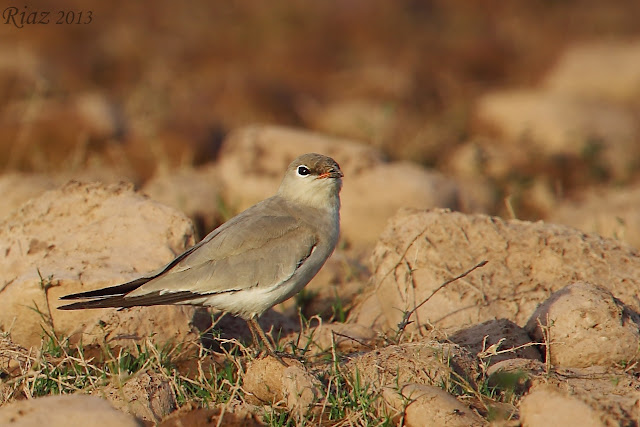Small Pratincoles at Rawal Lake
Another early start and the dawn of Saturday 8 June 2013
found us again at the eastern shoreline of Rawal Lake on the off chance of a
late passage migrant wader. Immediately, we noticed four birds in flight that
possessed distinctive black, white and sandy wing patterns and white rumps with
a black terminal band that was semi-circular in shape. These birds are a sort
of crossover between waders and terns. They were Prantincoles and this
particular species was SMALL PRATINCOLE Glareola
lactea, a scarce but regular summer visitor and very occasional breeder
around Rawal Lake.
 |
| Small Pratincole Riaz |
 |
| Small Pratincole (note distinctive tail pumping) Riaz |
Watching these birds one could not fail to marvel at their
graceful and buoyant flight as they hawked insects over the water. Such was
their aerobatic skills and speed RMK could not obtain a sharp flight
photograph. However, when the birds alighted on some shoreline rocks he did
manage to obtain these great photographs. Sadly, the illustrations in the Helm
Field Guide “Birds of Pakistan”, as with so many illustrations, fail to
replicate the actual colours of this species.
 |
| Red-wattled Lapwing Riaz |
Other than the Small Pratincoles the lake was fairly quiet.
There are still plenty of displaying PADDYFIELD PIPIT, ORIENTAL SKYLARK and
ZITTING CISTICOLA in the reeds and grassy areas and a little more concentrated
effort will locate some CRESTED LARK. The breeding BLACK-WINGED STILT are still
chasing HOUSE CROW away from their nests and young chicks and adult RED-WATTLED
LAPWING provide a second phase of aerial defence when the marauding Corvids
threaten their offspring.
 |
| Black-crowned Night Heron Riaz |
There were still four PHEASANT-TAILED JACANA and with two
being males and two females one wonders whether they will breed here later.
However, falling and rising water levels will be problematic if the promised
heavy rain arrives next week. There were still LITTLE RINGED PLOVER present but
no obvious signs of breeding was noted. From an earlier maximum of 200 there
was only one WHISKERED TERN present and no doubt that individual will move on
soon.
At Jinnah Road Marsh there were plenty of BLUE-TAILED
BEE-EATER but strangely no activity around those few weaver nests that have
survived since last breeding season. However, it is still early. A good sign
was a pair of ASIAN PIED STARLING building a nest on an electricity pylon and
another clear example of the range extension of this species further north into
Pakistan.
In the garden the nest and eggs of our pair of PURPLE
SUNBIRD have been destroyed by COMMON MYNA activity. HOUSE SPARROW in huge
numbers visit the feeders as do HIMALAYAN BULBUL on occasions. COMMON
TAILORBIRD, ORIENTAL WHITE-EYE, RED-VENTED BULBUL and ORIENTAL MAGPIE ROBIN all
come to the water we supply daily in the sweltering temperatures were are
experiencing with daytime highs of up to 46 degrees Celsius.
 |
| Indian Golden Oriole Riaz |
There will be a bit of a lull during the summer time high
temperatures as birds get on with breeding like the INDIAN ORIOLE pictured here. The onset of Monsoon will bring more migratory species into Pakistan and
we look forward to that time that will bring higher humidity but slightly lower
temperatures.


